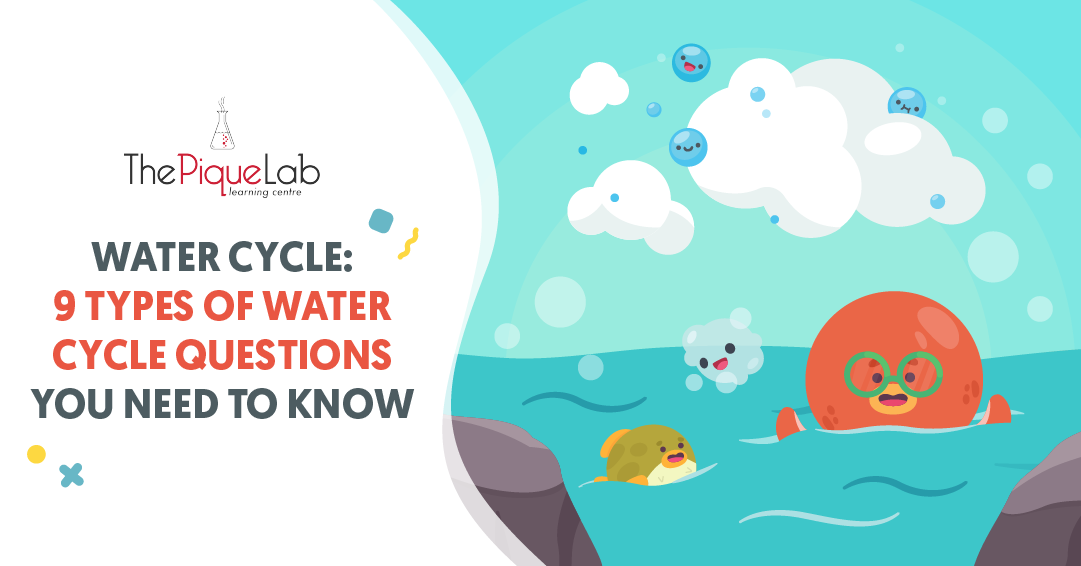Do you know the nine types of Water Cycle model questions that can be tested in your Science examinations?
In today’s article, I will be analysing an examination question on Water Cycle from the 2019 Raffles Girls’ Primary School (RGPS) P6 SA1 Examination Paper. I will also be discussing eight other types of questions that can be tested using the same or a similar model.
You may also choose to watch the video here.
Read Also:
Let’s Get Started On This Question!

Source: Raffles Girls’ Primary School – 2019 P6 SA1 Examination Paper [Q34]
When attempting a Water Cycle model question, we need to match its different components to the actual water cycle. Most models will include a water-based solution like sea water, saltwater, or juice, and a cover like a plastic sheet.
Here’re the different parts of the model:
1) Plastic sheet
The plastic sheet on top represents the surrounding air. When water droplets form on the underside of the plastic sheet, it represents clouds or rain.
2) Sea water
The sea water represents the water from water bodies.

Let’s Analyse Part (A)
“What would happen to the amount of water collected in the bowl if Bryan and his friends replaced the bowl with a smaller one? Explain your answer.”
What does the question mean by a smaller bowl? This means that the new bowl is narrower.
If the bowl is narrower, the sea water will have a larger exposed surface area. This means that the water within the sea water will evaporate faster.
⭐️ Tip: Take note of the specific phrasing that I have used to describe evaporation. Students must be specific when describing the process of evaporation.
To simply say that the sea water evaporates is akin to saying that a wet T-shirt evaporates and disappears when hung out to dry.

Now, it is also important to note that sea water has two main components: Water and salt. ONLY water will evaporate.
Suggested Answer For Part (A)
The amount of water collected in the bowl would increase.
Suggested Answer For Part (B)
If the bowl is narrower, the sea water will have a larger exposed surface area. Water in the sea water will gain heat faster from the warmer surrounding air or the sun to evaporate faster.
As more water evaporates from the sea water more quickly, more water vapour is formed. This warmer water vapour then rises, comes into contact with the cooler underside of the plastic sheet, loses heat to it and condenses to form more water droplets.
These water droplets will drip into the bowl to be collected. As there are more water droplets being formed, the amount of water collected in the bowl will increase.
Is Your Child Familiar With These Eight Water Cycle Questions?
The above question is one of the nine Water Cycle question types that we have identified. These are the other eight questions:
1) What Is The Purpose Of The Plastic Sheet?
Alternatively, the question can be phrased as “Why does the plastic sheet need to be there?”. Students need to be able to explain the purpose of the plastic sheet: If the plastic sheet is excluded from the set-up, no water droplets will form.
2) Explain The Formation Of Water Droplets.
The question can be phrased as “How did the water droplets form on the underside of the plastic sheet?”. This is usually related to question one, which we covered earlier.
3) What Happens If Ice Cubes Are Placed On Top Of The Plastic Sheet?
This is sometimes phrased as “What is the purpose of placing ice cubes on top of the plastic sheet?”.

4) What Happens If I Change The Temperature Of The Water Inside The Set-up?
Occasionally, instead of using warm water/sea water/juice, the set-up uses cold or iced water. Students must be able to explain where and how the water droplets will form in the set-up.
5) After Some Time, Why Do Less Water Droplets Start To Form On The Underside Of The Plastic Sheet?
As the water vapour loses heat to the plastic sheet, the plastic sheet will gain heat and become warmer. Because we now have a warmer surface, the water vapour that comes in contact with the plastic sheet will now lose heat to the plastic sheet more slowly and condense even slower to form less water droplets.
6) Will The Set-up Work If The Plastic Sheet Is Changed To An Aluminium Sheet?
This answer would depend on whether the set-up is placed under the sun or in the shade.

7) How Can I Increase The Rate Of Evaporation?
We will need to look at the four factors of evaporation: Wind, Humidity, Area of Exposed Surface, and Temperature.
8) What Is The Purpose Of The Stone In The Middle Of The Plastic Sheet?
The stone causes the plastic sheet to slope downwards. This ensures that the water droplets formed on the plastic sheet will slide to the middle and drip into the bowl.
Conclusion
I have explained how the different components of the above model reflect the actual water cycle. I have also shared the different examination questions that can be tested on this model or a variation of it so that your child can prepare for these questions beforehand and answer them accurately under the time pressure of an examination.
I hope that this was useful to you and your child! Stay tuned for more articles 🙂

If you like our methodology, we've some upcoming workshops:







